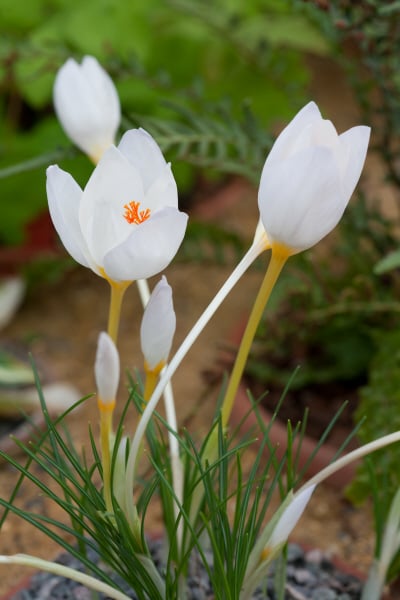Size
Ultimate height
0.1–0.5 metresTime to ultimate height
2–5 yearsUltimate spread
0–0.1 metreGrowing conditions
Moisture
Well–drainedpH
Acid, Alkaline, NeutralColour & scent
| Stem | Flower | Foliage | Fruit | |
| Spring | ||||
|---|---|---|---|---|
| Summer | ||||
| Autumn | Purple White Yellow | Green | ||
| Winter |
Position
- Full sun
Aspect
West–facing or East–facing or South–facing
Exposure
Exposed or Sheltered Hardiness
H6Botanical details
- Family
- Iridaceae
- Native to GB / Ireland
- No
- Foliage
- Deciduous
- Habit
- Tufted
- Potentially harmful
- Ornamental bulbs - not to be eaten. Wear gloves and other protective equipment when handling. Pets: Ornamental bulbs - not to be eaten - see the HTA guide to potentially harmful plants for further information and useful contact numbers
- Genus
Crocus are dwarf, deciduous perennials growing from a corm, with linear leaves usually with a silvery central stripe, and goblet-shaped, sometimes fragrant flowers in autumn or early spring
- Name status
Correct
- Plant range
- S Greece
How to grow
Cultivation
Grow in a gritty, poor to moderately fertile, well-drained soil in a sunny spot, or in an alpine house in a mix of equal parts loam, leaf mould and grit. Allow to dry out completely during summer dormancy. See crocus cultivation for more advice
Propagation
Propagate by seed sown in containers in a cold frame when ripe or remove cormlets when dormant
Suggested planting locations and garden types
- City and courtyard gardens
- Gravel garden
- Patio and container plants
- Rock garden
- Mediterranean climate plants
- Wildlife gardens
- Low Maintenance
Pruning
No pruning required
Pests
May be susceptible to rodents and birds
Diseases
Generally disease-free, corms may rot in storage
Get involved
The Royal Horticultural Society is the UK’s leading gardening charity. We aim to enrich everyone’s life through plants, and make the UK a greener and more beautiful place.
